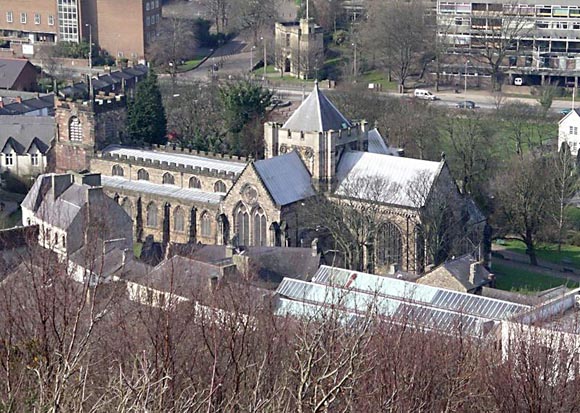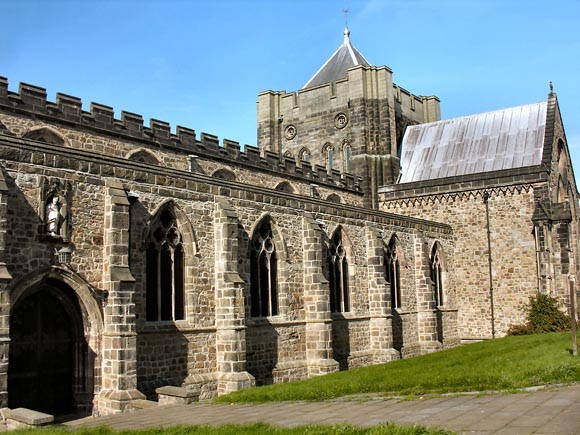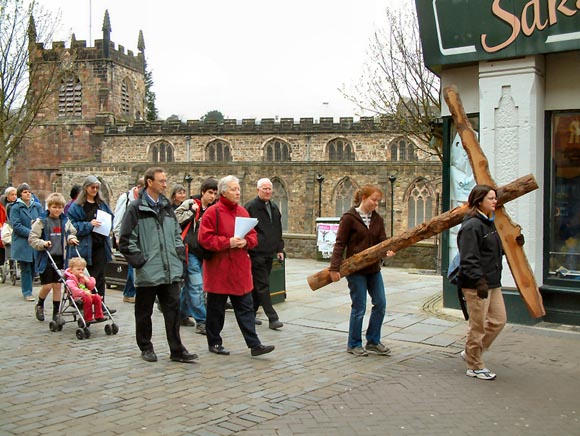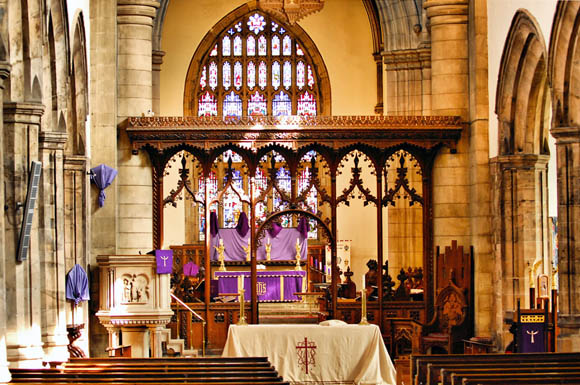Bangor Cathedral is a place of Christian worship situated in Bangor in North Wales in the United Kingdom. It is dedicated to Saint Deiniol.
The present building of Bangor Cathedral is not particularly old, but the site has been in use since the 6th century. The cathedral is built on a low-lying and inconspicuous site, possibly so as not to attract the attention of raiders from the sea. Visitors to Bangor often assume that the Gothic style building on the hill is the cathedral, but this is actually part of the University.
History
The site of Bangor Cathedral was originally occupied by St. Deiniol's monastery, established in the 6th century in ca. 525 on land given by the king of Gwynedd, Maelgwn Gwynedd. Saint Deiniol is said to have been consecrated as a bishop by Saint David, making him the first Bishop of Bangor. This monastery was sacked in 634 and again in 1073. Nothing of the original building survives.
The Synod of Westminster in 1102 is recorded as taking measures to restore Bangor Cathedral, but the earliest part of the present building was built during the episcopate of Bishop David (1120-1139) with the assistance of the king of Gwynedd, Gruffydd ap Cynan who donated money towards the project and was buried by the high altar on his death in 1137. This was a cruciform building in the Norman style, about 130 feet in length. Gruffydd's son, Owain Gwynedd was also buried here, as was his brother Cadwaladr. Giraldus Cambrensis describes a service held here in 1188 when the Archbishop of Canterbury celebrated mass.
In 1211, the Cathedral was destroyed by King John Lackland's men. In the 13th century the original apse was removed and the choir was extended to its present length. The church was badly damaged when King Edward I of England invaded Gwynedd in 1282, and in 1284 the Dean and Chapter were given �60 in compensation for the damage. There was extensive rebuilding in this period, under the first Bishop Anian, with the transepts and crossing rebuilt. The nave was rebuilt in the late 14th century.
The cathedral was said to have been burnt to the ground in 1402 during the rebellion of Owain Glyndŵr, but there is no contemporary evidence for this, though it may well have been damaged. There was extensive reconstruction from the end of the 15th century, completed in 1532. There is a Latin inscription over the tower doorway recording that Bishop Skevington built the tower in 1532, though it was not complete when Skevington died in 1533. Some work was done during the 18th century and �2,000 was spent on repairs in 1824, followed by the altering and refitting of the interior in 1825 at a cost of a further �3252.
Architecture
The building as seen today is the result of extensive work carried out under the supervision of Sir Gilbert Scott begun in 1868. Scott's design originally called for a high central tower and spire, but this was never completed as cracks appeared which were thought to indicate subsidence of the foundations. The tower was therefore left as a low structure.
Features of interest
The cathedral contains the "Mostyn Christ", a figure of Christ carved in oak thought to date from the late 15th century. It is unusual in that it depicts Christ prior to the crucifixion, seated on a rock and wearing the crown of thorns.
In the grounds of the cathedral, the "Bible Garden" was planted with an example of every plant mentioned in the Bible although only relatively few remain (2005). |




